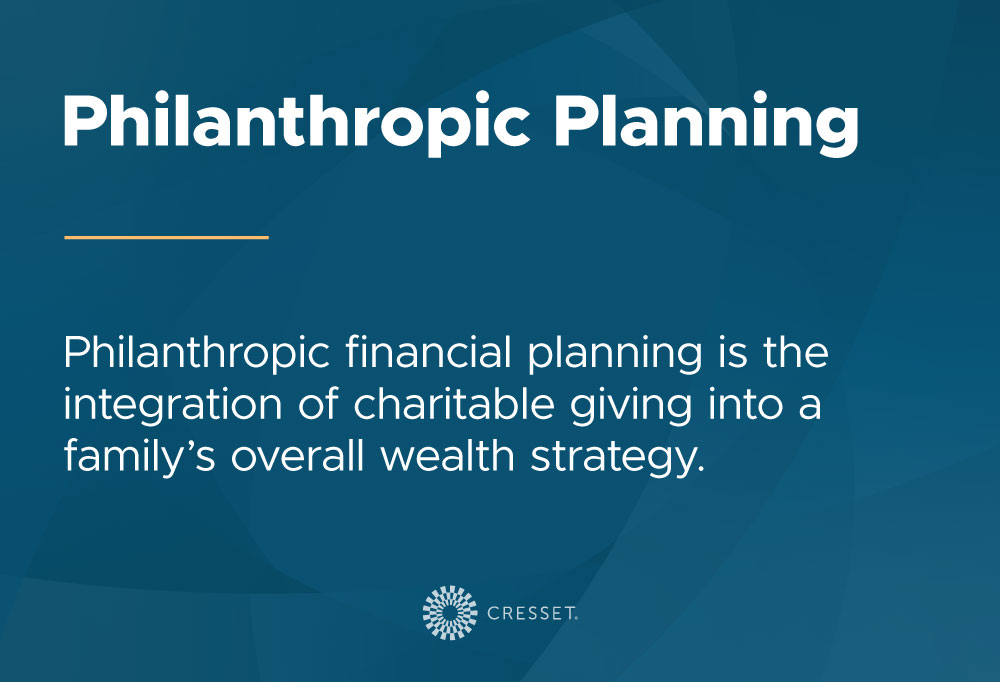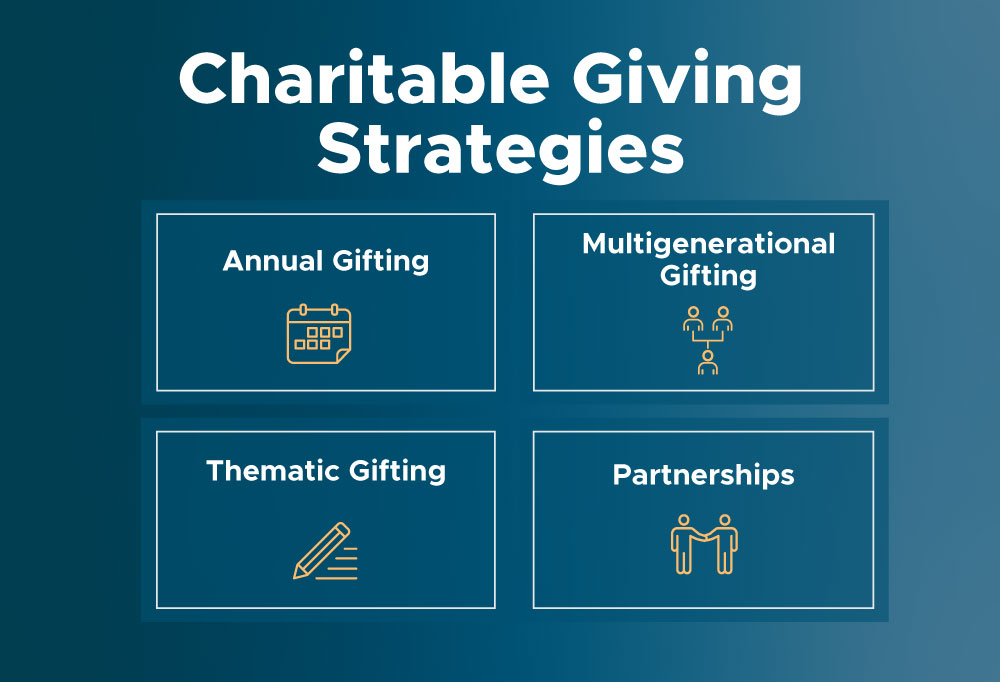Family Office Guide / Philanthropic Planning
By providing your email address, you consent to receive messages from Cresset regarding our services. View our Privacy Policy.

Managing Director, Head of Family Governance

Managing Director, Head of Family Governance
10 minute read
P hilanthropy is one of the most powerful ways families can shape their legacy and values across generations. For many affluent families, however, philanthropy often begins as a reactive and separate endeavor from financial planning, making ad hoc donations without tying them to the broader wealth strategy. While meaningful in the moment, this approach often misses the deeper benefits that come from intentional integration.
When philanthropy is intentionally aligned with wealth management, it becomes a powerful tool for building culture, purpose, and stewardship. Philanthropic financial planning ensures giving is both impactful and sustainable, honoring the human implications of decisions alongside the financial ones. Philanthropy can engage the rising generation in the stewardship of the broader family wealth, serving as a platform for conversations about responsibility, legacy, and governance.
Families today are crafting philanthropic plans in increasingly unique ways: blending donor-advised funds with charitable remainder trusts, creating family foundations alongside impact investing portfolios, or structuring generation-skipping charitable trusts that support causes while modeling stewardship for heirs. By combining vehicles, families can achieve both flexibility and tax efficiency while tailoring their giving to reflect their values.
Case Study Snapshot: One multigenerational family partnered with their family office to design a philanthropic plan that blended a donor-advised fund for annual giving with a charitable lead trust that supported a university scholarship program. The older generation appreciated the immediate tax benefits and the ability to make consistent, long-term commitments to education. Meanwhile, the younger generation took ownership of the DAF’s grantmaking committee, researching nonprofits and presenting recommendations at family meetings. The result was not only amplified charitable impact but also stronger family bonds, clearer communication, and an engaged next generation beginning to see themselves as stewards of both capital and values.

Philanthropic financial planning is the integration of charitable giving into a family’s overall wealth strategy. It goes beyond making one-off donations. Instead, it creates a structured, long-term approach that:
When coordinated within a family office framework, philanthropy becomes a core element of wealth stewardship—bridging financial management with purpose.
Families often ask, “What’s the benefit of making philanthropy part of our financial plan?” The answer lies in the multi-dimensional impact:
Strategic philanthropy blends financial expertise with purpose-driven giving. Some common approaches include:
Case Study Snapshot: A multigenerational family in the Midwest created a private foundation to fund arts and cultural initiatives in their community. To expand their impact, they layered in impact investments within their broader portfolio, channeling capital into renewable energy and sustainable agriculture ventures that aligned with their family values. In addition, the foundation made PRIs in local affordable housing projects, providing low-interest loans to nonprofit developers. This three-tiered approach—traditional grantmaking, impact investing, and PRIs—not only diversified their philanthropic strategy but also engaged different generations of the family: the grandparents focused on arts grants, parents oversaw the PRI housing investments, and younger family members took the lead in exploring new impact investing opportunities. The result was a dynamic, values-driven plan that combined financial efficiency with community transformation.
Successful planned giving requires forethought and discipline. Best practices include:
Case Study Snapshot: A multigenerational family established a charitable remainder trust (CRT) to support healthcare research while also providing retirement income for the parents. To expand flexibility, they paired the CRT with a donor-advised fund (DAF) that the grandchildren managed, choosing nonprofits to support each year. The family also participated in a pooled giving fund with other philanthropists, enabling them to collectively tackle larger systemic challenges in education. This layered approach not only advanced medical innovation and broadened impact but also created meaningful roles for each generation, ensuring that both financial stewardship and family culture were carried forward.
Philanthropic financial planning is not one-size-fits-all. Families may consider:

Philanthropy becomes most effective when treated as an intentional, coordinated part of wealth strategy. A family office can help:
When guided by a family office, philanthropy is not just about writing checks—it’s about creating a meaningful legacy that balances purpose with financial responsibility.
Philanthropic financial planning allows families to maximize their impact, reinforce shared values, and extend their legacy across generations. With the right strategy and guidance, giving becomes not only rewarding but transformative.
At Cresset, we partner with families to design philanthropic strategies that align with their financial and personal goals, helping them turn generosity into lasting impact.
This document does not constitute advice or a recommendation or offer to sell or a solicitation to deal in any security or financial product. It is provided for information purposes only and on the understanding that the recipient has sufficient knowledge and experience to be able to understand and make their own evaluation of the proposals and services described herein, any risks associated therewith and any related legal, tax, accounting or other material considerations. To the extent that the reader has any questions regarding the applicability of any specific issue discussed above to their specific portfolio or situation, prospective investors are encouraged to contact [XYZ] or consult with the professional advisor of their choosing.
Certain information contained herein constitutes “forward-looking statements,” which can be identified by the use of forward-looking terminology such as “may,” “will,” “should,” “expect,” “anticipate,” “project,” “estimate,” “intend,” “continue,” or “believe,” or the negatives thereof or other variations thereon or comparable terminology. Due to various risks and uncertainties, actual events, results or actual performance may differ materially from those reflected or contemplated in such forward-looking statements. Nothing contained herein may be relied upon as a guarantee, promise, assurance or a representation as to the future.
By providing your email address, you consent to receive messages from Cresset regarding our services. View our Privacy Policy.